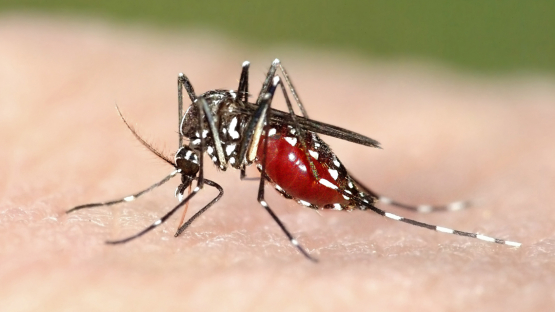A nuclear technique successfully used to control the spread of various pests could, in the future, contribute to combatting mosquitoes and the diseases they carry. These tiny insects are responsible for spreading malaria and dengue that wreak havoc over large parts of the world, causing sickness and death.
"Mosquitoes and the diseases they transmit are already a severe problem; the problem is becoming worse due to globalization and climate change, so there’s an increasing interest among our Member States in the development and use of nuclear techniques against mosquitoes," said Marc Vreysen, Head of the Insect Pest Control Laboratory operated jointly by the IAEA and the Food and Agriculture Organization of the United Nations (FAO).
According to the World Health Organization, approximately half of the world's population is at risk of malaria and around half a million people die of the disease each year. Ninety percent of these deaths occur in Africa, where one child dies from malaria every minute. Dengue leads to an estimated 12 500 deaths annually, mainly among children, and the incidence of dengue has grown dramatically in recent decades.
Although conventional insecticide-based mosquito control methods, such as bed nets and repellents, have proven to be effective under certain conditions, resistance to insecticides is increasing and scientists are constantly looking for new ways to tackle these pests.
A nuclear tool: Sterile Insect Technique
A method using nuclear technologies, known as the sterile insect technique, or SIT, could provide a future option for mosquito control.
"SIT is a very robust technology. It is proven that it can work for various major pests, such as fruit and tsetse flies, screwworms and moths, for over 50 years and in many parts of the world," Vreysen said.
SIT uses radiation to sterilize male flies, which are mass-produced in special rearing facilities. Large numbers of sterile males are then released into a target area, where they mate with wild females.
No offspring are produced, and — as sterile males gradually outnumber fertile ones — the wild fly population declines over time.
This cost-effective and environmentally-friendly technique, used in more than 20 countries worldwide, is particularly successful in areas with isolated insect populations, where wild fertile females cannot fly in from neighbouring regions to re-establish insect populations, Vreysen explained.
Mosquitoes, however, are a different story. Because they are ubiquitous in many parts of the world, wild males are much harder to crowd out. This necessitates further research to tackle mosquitoes using SIT, Vreysen said. It may take several years before the technique is available on a large scale, he estimated.
Experimenting with mosquitoes
As the first step, a mass-rearing system has been developed at the IAEA/FAO Insect Pest Control Laboratory in Seibersdorf, Austria. "This is a first major step in any SIT programme," Vreysen explained, "as a large number of insects are required for eventual release."
This system includes holding cages for adult insects and trays where the larvae can develop for mass-production. The scientists have also developed a special larval diet and determined the sterilizing doses. (See the photo essay: Preventing Procreation: The IAEA's Research for Mosquito Control).
"The main challenge we now have is to develop a good sex-separation system that can eliminate the female mosquitoes from the production line, so that only sterile males, which do not transmit disease, can be released into the wild," Vreysen said. This is important, because if females are reared and released, they could spread, rather than control, the disease.
At the Insect Pest Control Laboratory, up to 125 000 adult mosquitoes are currently held. They are from three different species that can transmit malaria and dengue. The work here includes research into various irradiation methods and the effects of mass rearing, handling and sterilization on the fertility and competitiveness of male mosquitoes.
At the laboratory, the interaction between fertile and sterile males competing for females is closely observed in a greenhouse designed to mimic the natural habitat of these tropical pests.
The IAEA/FAO laboratory has already provided some of the essential equipment and technology needed for mosquito mass rearing to several countries, such as China, Indonesia, Malaysia, Pakistan, the Philippines, Sri Lanka, South Africa, Sudan and Thailand. It has also trained entomologists from a number of IAEA Member States, and Sudan is building a mass-rearing facility based on a design that was developed by the FAO/IAEA experts. (Click here to listen to Sudanese experts describing the project and its results).
South African mosquitoes: not yet an endangered species
Oliver Wood, a South African entomologist, recently spent six months at the IAEA/FAO laboratory and has since returned to the Wits Research Institute for Malaria and the National Institute for Communicable Diseases in Johannesburg.
"At the Seibersdorf lab, I was able to gain experience in handling, maintaining and manipulating a large-scale colony of mosquitoes," he said. He also learned about the performance and costs of the pieces of equipment needed for the various life stages of mosquitoes.
"Once our mass-rearing facility is built, the skills acquired will be put to use in managing the facility and the rearing for release," said Wood.
In South Africa, an effective malaria control programme has pushed back the malaria distribution to low-lying border regions and has brought the number of cases reported annually down to less than 10 000. "Given that the populations are already quite well-controlled with our current methods, and the population sizes are already suppressed, it makes the SIT very attractive," he said.
Releasing sterile males
Back in Austria, the FAO/IAEA experts are also researching methods for releasing sterile mosquitoes into the wild. Once countries have reared a sufficient number of sterile males, trial releases can begin.
"Mosquitoes are fragile insects that require delicate handling and release methods. Initially, when the project sizes are still small, the sterile mosquitoes could be released from cars or boats," said Vreysen. For larger scale implementation, aerial release techniques will have to be developed that can introduce the adult insects into the wild without harming them.




